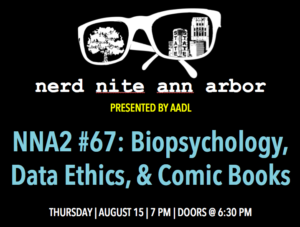
Another Nerd Nite A2 is coming your way! This one features U-M PhD candidate in biopsychology Sofia Carrera explaining how neurotransmitters affect our behavior and feelings, U-M engineering PhD candidate Ben Swerdlow discussing the moral quandaries that may occur when algorithims are applied to the sheer quantity of personal data that is collected, and Ryan Tamaroff walks us through the history of comic books.
When: Thursday, 8/15/19
Doors at 6:30/talks at 7 pm
Where: LIVE, 102 S. First St
Cost: This one’s on your friendly neighborhood Ann Arbor District Library!!
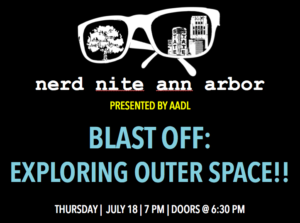
It’s an all-star, all-SPACE lineup for this round of NNA2, friends! In honor of the 50th anniversary of the moon landing, we are exploring the final frontier with three amazing talks!
Electrical engineer Jordan Budhu will walk us through the communication tools used by exploration rovers to beam their findings back to Earth’s eager audiences. Space enthusiast Sam Carpenter will be telling the story of NASA’s Apollo missions. Astronomy PhD candidate Larissa Markwardt will outline the search for as-as undiscovered planets lurking at the edges of our solar system.
It’s going to have SCIENCE! It’s going to have HISTORY! It’s going to be STAR*-STUDDED! (*As in, you know, gas balls.) It’s going to be fun and interesting and eye-opening and great so text a friend now and tell them you’ll see them there!
When: Thursday, 7/18/19
Doors at 6:30/talks at 7 pm
Where: LIVE, 102 S. First St
Cost: Free! With love, from your friends at the Ann Arbor District Library!
 Jordan Budhu – Talking to Other Planets: Antennas for Satellites and Planetary Exploration Rovers
Jordan Budhu – Talking to Other Planets: Antennas for Satellites and Planetary Exploration Rovers
Billions of dollars are spent on developing spacecraft and planetary exploration rovers to probe the universe or visit other planets, however, the most important component on these spacecraft is the communications antenna. This talk will explore the concept of electromagnetic radiation and the fundamental working principles of antennas. Then we will discuss some designs for planetary exploration rovers and satellite spacecraft. The listener will leave with an understanding of how an antenna radiates and how we use them to communicate with space-borne instruments.
About Jordan:
He received his M.S. degree in electrical engineering from the California State University, Northridge, California, USA, in 2010, and the Ph.D. degree in electrical engineering from the University of California, Los Angeles, California, USA, in 2018. He is currently a Research Fellow in the Radiation Laboratory at the University of Michigan, Ann Arbor, Michigan, USA. In 2011 and 2012, he was a Graduate Student Intern at the NASA Jet Propulsion Laboratory. In 2017, he was named a Teaching Fellow at the University of California, Los Angeles. His research interests are in antenna theory, computational electromagnetics algorithms, and scattering from inhomogeneous, anisotropic materials. Dr. Budhu’s awards and honors include the 2010 Eugene Cota Robles Fellowship from UCLA, the 2012 Best Poster award at the IEEE Coastal Los Angeles Class-Tech Annual Meeting, the 2018 Henry Samueli School of Engineering and Applied Science Excellence in Teaching Award at UCLA, and the first place award for the 2019 USNC-URSI Ernst K. Smith Student Paper Competition at the 2019 Boulder National Radio Science Meeting.
 Samuel Carpenter – Making the Impossible Possible: Lessons from Apollo
Samuel Carpenter – Making the Impossible Possible: Lessons from Apollo
In 1962 under President Kennedy’s direction, our nation committed itself to “landing a man on the moon and returning him safely to earth.” At the time, this goal was physically impossible. In order to accomplish this goal, it had to be broken down into component tasks. Accomplishing these tasks determined the mission objectives of the Mercury, Gemini and Apollo programs. I will discuss not only the accomplishments these early space exploration efforts but I will also outline a general process of how to take on impossible goals. You will be able to apply this process in your own lives in order to achieve your ‘impossible’, whatever that happens to be.
About Samuel:
Samuel is a Pennsylvania native who recently relocated to Ann Arbor from Portland, OR. Throughout a career in academic research and volunteering as a prehospital medical provider, he has maintained an avid interest in space exploration history as well as current progress of existing space programs. Find him on Twitter @carpensa1.
 Larissa Markwardt – Hidden Planets
Larissa Markwardt – Hidden Planets
Could there be a planet lurking at the edge of our Solar System that we haven’t discovered yet? Maybe! It’s happened before. In this talk, I will explain how the orbits of objects we already know about in our Solar System can be used to infer the existence of yet unseen planets. I will also discuss the history and science of the discoveries of Neptune and Pluto, searches for other hypothetical planets (Planet X and Vulcan), and the current hunt for Planet 9.
About Larissa:
Larissa is a PhD candidate in Astronomy and Astrophysics and NSF graduate research fellow at the University of Michigan. She studies tiny, faint, and distant space rocks in our Solar System, specifically Earth Trojans and Kuiper Belt Objects. In her free time she likes to go hiking and kayaking, play board games, and watch Stargate. Find her on Twitter @LarMarStar.
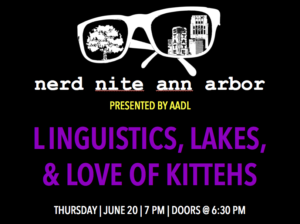 And we’re back! June’s Nerd Nite A2 has it all – little-known language facts, a battle for the GREATEST Lake (water quality issue), and a deep, objective examination of why cats are, scientifically, just the best.
And we’re back! June’s Nerd Nite A2 has it all – little-known language facts, a battle for the GREATEST Lake (water quality issue), and a deep, objective examination of why cats are, scientifically, just the best.
Linguist and standup comedian Emily Rae Sabo will teach us 10 things we need to know about language, including why English spelling is so W-E-I-R-D. Research technician Christine Kitchens will break down the water quality issues plaguing two of the Great Lakes, specifically, too much algae and not enough algae. Cat lover Jessica Amey will discuss feline domestication, variances by breed, and anatomical traits, such as relative cuteness of kitty toe beans.
Join us to laugh at language, marvel at lake ecosystems, and celebrate cats just being cute and great all the time, scientifically speaking, of course. Bring a friend, grab a beer, and settle in for another great NNA2!
When: Thursday, 6/20/19
Doors at 6:30/talks at 7 pm
Where: LIVE, 102 S. First St
Cost: Free! This night out is sponsored by the Ann Arbor District Library!
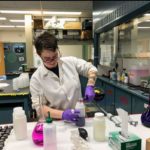 Christine Kitchens: A Tale of Two Lakes: Eutrophy in Western Lake Erie and Oligotrophy in Lake Michigan
Christine Kitchens: A Tale of Two Lakes: Eutrophy in Western Lake Erie and Oligotrophy in Lake Michigan
In Western Lake Erie, massive mats of blue-green algae blossom every summer, stirring up memories of the 2014 Toledo Water Crisis with every reappearance. Meanwhile, in Lake Michigan, there are nearly as many invasive mussels in the lake as there are gallons of water. Each mussel is the size of a thumbnail and, under the right conditions, their combined force can filter the entire volume of water in Lake Michigan in less than a week. The resulting crystal clear waters are great for beachgoers but extremely problematic for the lake ecosystem. In this talk, we’ll discuss some of the causes of eutrophy (too much vegetation) in Western Lake Erie and oligotrophy (too little vegetation) in Lake Michigan and how lake-wide management strategies for one problem can exacerbate another.
About Christine:
Christine Kitchens is a research technician at the Cooperative Institute for Great Lakes Research at the University of Michigan. She graduated with a B.S. in Environmental Science from North Carolina State University and an M.S. in Conservation Ecology from the University of Michigan. While she performs a variety of tasks at the cooperative institute, she primarily spends her days helping monitor and understand harmful algal blooms in Western Lake Erie and Saginaw Bay, Lake Huron. When she does manage to find some free time, she spends it running around doing more volunteering with the Huron River Watershed Council and other various local environmental organizations, playing video/board games, and basically being a massive nerd in all facets of life.
 Emily Rae Sabo – 10 Things you Need to Know about Language
Emily Rae Sabo – 10 Things you Need to Know about Language
You speak a language, so you know everything about how language works, right? Wrong! In this talk, we’ll cover the Top 10 things most people don’t know about language. In doing so, I’ll dispel several common myths and reveal some fascinating facts about the systems we use every day to communicate with each other. If you’ve ever wondered how many languages there are in the world, why language death is on the rise, where grammar comes from, or how it is that kids learn language so effortlessly – this talk is for you! Or, if you simply find yourself in need of a few high-quality conversation starters for your upcoming work party, this talk will prepare you to explain what exactly the Bilingual Advantage is, why British accents sound smart, how whistled languages work, whether Spanglish is a language, which high-profile court case was a glaring example of linguistic discrimination, and why English spelling is such a mess.
About Emily:
By day, I’m a researcher and PhD student of Linguistics at The University of Michigan. By night, I’m a local standup comedian at dive bars near you. In my work as a linguist, I compare how monolingual and bilingual listeners respond to various types of lexical ambiguity and speech errors in order to investigate the cognitive mechanisms that underlie language processing as well as the social priming that modulates how people perceive Spanish-accented English in the U.S. today.
 Jessica Amey – Cats: A look into the feisty feline
Jessica Amey – Cats: A look into the feisty feline
We’ll take a look into domestication of cats, cultural influences and a few cat anatomy characteristics. There will also be interactive trivia on different cat breeds.
About Jessica:
Jessica loves cats and will have prizes for cat trivia winners.
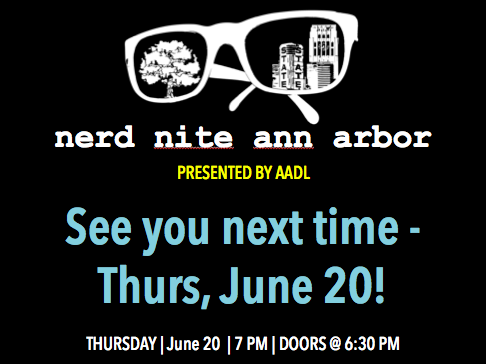
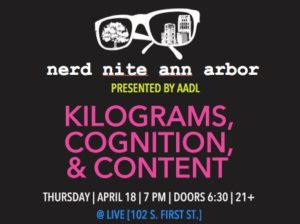 It’s going to hard to MEASURE how much INTELLIGENCE (artificial and otherwise) and DATA are coming together to make April’s NNA2 great!
It’s going to hard to MEASURE how much INTELLIGENCE (artificial and otherwise) and DATA are coming together to make April’s NNA2 great!
We’ll have NSF calibration officer Heather Wade with the tale of the kilogram standard and its recent reconfiguration. U-M Ph.D. candidates Steven Jones and Bryan Stearns will outline the role cognitive architecture plays in artificial intelligence. RELATE alum and Ph.D. candidate Ben Swerdlow will discuss the intersection of Big Data and ethics. This month’s NNA2 will amaze, inform, and entertain, so invite a friend, grab a drink, and find a seat for another excellent NNA2!
When: Thursday, 4/18/19
Doors at 6:30/talks at 7 pm
Where: LIVE, 102 S. First St
Cost: Free! This night out is sponsored by the Ann Arbor District Library!
 Ben Swerdlow – The Medium Place: Big Data and Ethics
Ben Swerdlow – The Medium Place: Big Data and Ethics
We deal with big data every day through social media, advertisements, digital assistants, and more. However, big data is also used in finance, health care, and criminal justice to make choices that impact many, but often behind the scenes. In this talk, I will go over how algorithms learn from data, how this process can unintentionally go wrong, and what ethical questions arise when they do. These questions will not be settled by the end of the talk, but in discussing them I hope we can learn to think more critically about the data-fueled world around us.
About Ben:
Ben is a Ph.D. candidate at the University of Michigan studying materials science and engineering through computer simulations of self-assembling nanoparticles. As part of his studies, he learned about the predictive power of data science as well as the ethical considerations presented at this talk. When not thinking about materials science or big data, you can find him watching YouTube videos, playing board or video games with friends, or cooking.
Steven Jones and Bryan Stearns – The Cogs of Cognition

 Human thinking can do some amazing things – sometimes! And sometimes our thinking doesn’t work out so well. Either way, thinking seems to happen very fast and seems to use a fixed set of components. How do we do it? Sure, we (humans) do thinking with neurons, but our talk will focus on describing some high-level systems that describe how the brain works, and which we can use to simulate (sometimes intelligent!) human behavior.
Human thinking can do some amazing things – sometimes! And sometimes our thinking doesn’t work out so well. Either way, thinking seems to happen very fast and seems to use a fixed set of components. How do we do it? Sure, we (humans) do thinking with neurons, but our talk will focus on describing some high-level systems that describe how the brain works, and which we can use to simulate (sometimes intelligent!) human behavior.
About Steven and Bryan:
Steven and Bryan are both Ph.D. candidates at the University of Michigan researching cognitive architectures. Bryan studies the computational principles of skill representation and learning. In his spare time, he likes reading, videography, theology, learning new skills, and singing when no one is listening. Steven studies how we record and use long-term memories. He enjoys video games, board games, and dystopic settings.
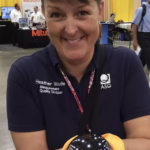 Heather Wade – The Life and Death and Life of the Kilogram
Heather Wade – The Life and Death and Life of the Kilogram
The kilogram was the last remaining human-made physical base measurement artifact and which served as the base measurement of mass. It has been redefined based on unchanging natural physical constants. So, like the second, the meter, the ampere, the Kelvin, the candela, and the mol, it can be created and proven anywhere and the value won’t change. Come and learn about the new kilogram and how it’s defined.
About Heather:
Heather is proud to be a big nerd. She holds a BS in Biology from the University of Michigan. She has worked as a microbiologist, an extraction and analytical chemist, a physical test engineer, and a water treatment specialist before finding her way into the field of metrology. She is currently Calibration Officer at NSF International, in Ann Arbor, MI; an independent, not-for-profit and non-governmental organization committed to protecting public health and safety worldwide. She has experience in chemical, mass, dimensional, time, electrical, pressure, flow, temperature, and luminous intensity calibrations. She is responsible for supporting all of the test equipment, developing and validating calibration methods, ensuring staff competency, and developing uncertainty budgets. Heather holds ASQ-CCT (Certified Calibration Technician) certification and has been a leader and subject matter expert for the ongoing development of the ASQ-CCT exam. She is currently Treasurer and a past Chair of ASQ Measurement Quality Division (MQD). She’s published in several nerdy publications, including in ASQ-MQD’s “The Standard” and in Cal Lab Magazine; The International Journal of Metrology. Heather is one of the co-authors of The Metrology Handbook, 2nd Ed., edited by Jay Bucher. To further her “nerd-cred”, she is also featured in the Cool Careers in Metrology DVD and website. She has presented papers at Measurement Science Conference, NCSL International Conference, the 21st Asia-Pacific Quality Conference, 2014 China Conference on Quality, and the 10th Shanghai International Symposium on Quality. She is an active member of NCSLI’s Testing Lab committee and Test Equipment Asset Management committee and its subcommittee on Delay Dating. She is also a previous speaker at Ann Arbor’s Nerd Nite.
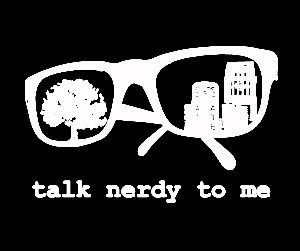
NNA2 is dishing up another informally informative evening and we want YOU to join us! Our menu features specials including mathematics Ph.D. student Jasmine Powell exposing the freakiness of fractals and their never-ending patterns, astronomy Ph.D. student Gillen Brown explaining how stars blew up a million years ago and landed all over our periodic table, and evolutionary biologist and virologist Kayla Peck shares Louis Pasteur’s legacy through crystals, milk, and rabies. Pull up a chair and enjoy!
When: Thursday, 3/21/19
Doors at 6:30/talks at 7 pm
Where: LIVE, 102 S. First St
Cost: Free! This night out is sponsored by the Ann Arbor District Library!
 Gillen Brown – Origin of the Elements
Gillen Brown – Origin of the Elements
Just after the Big Bang, hydrogen and helium were the only elements in the universe. 14 billion years later, we have everything from argon to zinc. The story of how the elements were made includes the beginning of the universe itself, the death throes of stars like our sun, and at least three types of exploding stars. I’ll cover the handful of ways the universe builds elements, then walk through the periodic table to show where each element comes from.
About Gillen:
Gillen is a Ph.D. student in the astronomy department at the University of Michigan, where he studies how elements are distributed within galaxies by using computer simulations. When not writing code, he enjoys watching sports, camping throughout the beautiful state of Michigan, and riding roller coasters.
 Jasmine Powell – Funky Fractals
Jasmine Powell – Funky Fractals
While the spotlight on math often takes the form of its many direct applications to problems in other fields, there’s another, quieter side of math lurking in the background: understanding and solving problems arising not from any real-world issues, but instead from abstract patterns. Throughout this talk, we’ll delve into my own research on this side of things, and in the process will discover a collection of intricate, beautiful, surprising abstract shapes called fractals. Through talking about what I do and why I love it, I’ll touch on questions about what “pure math research” looks like and why it’s not as intimidating as it sounds.
About Jasmine:
Jasmine is a Ph.D. candidate in mathematics at the University of Michigan and a native Ann Arborite. She loves thinking about math: how to learn it, how to teach it, and how to extract its intrinsic beauty. When she’s not at a local coffee shop working on research, you can find her playing board games, doing an escape room, or embarking on her quest to eat at every restaurant in Ann Arbor.
 Kayla Peck – Crystals, Milk, and Rabies: LP’s legacy
Kayla Peck – Crystals, Milk, and Rabies: LP’s legacy
French scientist Louis Pasteur left his mark on science in a bunch of weird ways. Let’s explore them together!
About Kayla:
Kayla first became an LP fangirl sometime in 2007 during Organic Chemistry I. Coincidentally, her career path also resulted in the study of deadly pathogens. She earned her PhD in Biology in 2016 and is primarily interested in virus evolution and how viruses emerge into humans. When not in lab, she can be found catching pokemon, reading medieval fantasy, playing scrabble, or coming up with new Shrek drinking game rules.
NNA2 wants to know: How sturdy is YOUR skeleton?!!? No idea? Well, chemistry grad student Isabel Colón-Bernal will help clue you in. Assistant professor of Slavic languages and literatures Ania Aizman will be introducing us to anarchy and if you’re wondering where we could possibly be going next, neuroscience grad student Sharena Rice will be our guide through the labyrinth of brain functions that results in navigation. It’s going to be nerdy, it’s going to be night, it’s going to be all the things you ever dreamed Nerd Nite A2 could be! Hope you can join us for another great NNA2.
When: Thursday, 2/21/19
Doors at 6:30/talks at 7 pm
Where: LIVE, 102 S. First St
Cost: $0, I know, what a deal, right?
 Sharena Rice – A Brief History of [Inner] Space: Understanding the Brain’s GPS
Sharena Rice – A Brief History of [Inner] Space: Understanding the Brain’s GPS
Where are we? How do we know it? Where are we going? In this talk, I will discuss how the three-pound organ between our ears helps us find our way from point A to point B.
About Sharena: I am pursuing a Ph.D. in neuroscience and an MS in bioinformatics at the University of Michigan. Deep life conversations enthrall me. I can be found playing the electric saxophone in a Buddhist temple. My project uses virtual reality, robots, and lasers to understand how the brain navigates through space. Yes. I occasionally get lost.

Ania Aizman – Anarchism in Russia and the US
Nowadays anarchists are variously seen punching Nazis, setting police cars on fire, or offering free bike repair and starting community gardens. Is there a coherent set of ideas uniting these things? Is there a history to them? One way to tell the origin story of anarchism is to trace its emergence in Russia, from its successes and failures in the revolutionary movement against Tsarism to its persecution by the Soviet regime. Driven to exile, anarchists from Russia and Eastern Europe came to New York, helping to establish anarchist collectives across the United States.
About Ania: Like many people raised on Russian novels, I was drawn to radical ideas from an early age. But I walked into my first political demonstration by accident, and I practically stumbled on this topic (anarchism in Russia) as an academic, a researcher. There’s work to do to fill in the historical gaps, because no government — Tsarist, Soviet, or any other stripe — likes opposition to the state as such. Censorship and persecution have been with the anarchists from the beginning, but so have their various strategies of survival. Works of art and literature where radical ideas persisted are the focus of my research. I’m a member of the Michigan Society of Fellows and assistant professor of Slavic Languages and Literatures at U of M.

Isabel D. Colón-Bernal – The Chemistry that Backs Our Bones
Osteoporosis is a degenerative bone disease affecting about 75 million people worldwide. Recently, a link between what bones are made of, or composition, and how easily they break, or fracture risk, has been found. In addition, we know that composition is related to fracture risk, yet it has not been studied at the proper scale. In my research, I’m using AFM-IR to look at bone composition at ~50nm. I want to understand how bone composition at the nanoscale can affect a bone’s biomechanical properties at the macro scale. I want to see how bone composition can vary with disease and treatment. Understanding what bones are made of and how this changes their biomechanical properties will improve our understanding of osteoporosis, and how to treat it.
About Isabel: Isabel is a graduate student and scientific communications writing fellow in the Chemistry Department at the University of Michigan. As a member of the Banaszak Holl Lab, her research is on understanding the change in chemical composition of bones and microstructure of collagen as a function of disease and treatment, and how this relates to mechanical properties. She came to Michigan after graduating from her bachelor’s degree in Chemistry from the University of Puerto Rico Rio Piedras campus. Find her @BoriChemist.
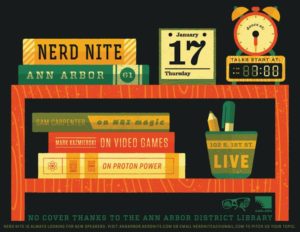 For NNA2 #61, we’ll be diving into MRIs and what we can and cannot learn about the brain with neuroscience researcher Sam Carpenter, exploring how protons are structured, inside and out, with physics grad student Nicole Lewis, and talking about why we play – or don’t play – video games with Mark Kazmierski. So come pick up some facts you didn’t know before and use ‘em to wow your non-Nerd Nite A2 friends! As always, it’s free, courtesy of the Ann Arbor District Library, so grab a friend, grab a drink, and enjoy another informal/informative evening at NNA2!
For NNA2 #61, we’ll be diving into MRIs and what we can and cannot learn about the brain with neuroscience researcher Sam Carpenter, exploring how protons are structured, inside and out, with physics grad student Nicole Lewis, and talking about why we play – or don’t play – video games with Mark Kazmierski. So come pick up some facts you didn’t know before and use ‘em to wow your non-Nerd Nite A2 friends! As always, it’s free, courtesy of the Ann Arbor District Library, so grab a friend, grab a drink, and enjoy another informal/informative evening at NNA2!
When: Thursday, 1/17/2019
Doors at 6:30, talks at 7 pm
Where: LIVE, 102 S. First St.
Cost: Free! Gee, thanks, AADL!
 Sam Carpenter – MRI: Magic Really-cool Images
Sam Carpenter – MRI: Magic Really-cool Images
We often hear in the media about some new scientific study where “brain scans reveal something interesting” But often, not a lot of effort goes into describing what is meant by a “brain scan”, how they work and what they can tell us. A common method of “brain scan” is Magnetic Resonance Imaging (MRI). I’ll be breaking down what an MRI is, how they work and what we can and cannot learn about the brain.
About Sam: I am a Pennsylvania native who relocated to Portland, OR in 2010 where I started working in behavioral neuroscience research at Oregon Health & Science University. My technical experience with MRI physics via Penn State set me up to be a part of one of the largest longitudinal neuroimaging adolescent studies at the time. On the job, I learned how to code in a variety of languages, build and run image processing pipelines as well as how to talk ADHD children still for 2+ hrs in the MRI machine. I have scanned over ~1000 individuals ranging in age from 12 days to 88 years. I started in an M.S. program in Bioinformatics at OHSU in 2016 but withdraw in order to move with my spouse to Ann Arbor for a career opportunity. Check me out on Twitter @carpensa1.
 Mark Kazmierski – Game On! Why you do (or don’t) Play Video Games
Mark Kazmierski – Game On! Why you do (or don’t) Play Video Games
What makes games so addictive. In a world of over-stimulation and short attention spans, what makes games the thing that we are drawn to? We will attempt to break down what keeps people playing, as well as what prevents people from getting started.
About Mark: A 29-year-old gamer who has playing since he had the strength to lift a controller, Mark Kazmierski has always had just as much an interest in the culture and development of games as he does playing them. He’s no gaming professional, he’s just a regular guy with enthusiasm about something he loves. Follow him @Kazman2007.
 Nicole Lewis – Unpacking the Proton
Nicole Lewis – Unpacking the Proton
Scientists have known since the 60s that the proton is made of smaller particles called quarks and gluons that are tightly bound together by the strong nuclear force. This process is responsible for 98% percent of the mass of the visible universe. Which would be great if we had any idea how it worked. I study proton-proton collisions that are at a high enough energy that the proton breaks up into a spray of particles. By studying the particles that come out of this spray and how they are arranged in space, we can learn more about the internal structure of the proton
About Nicole: Nicole is a physics PhD student at the University of Michigan studying the structure of the proton and part of the PHENIX collaboration at Brookhaven National Lab. When not thinking about work, she spends most of her time thinking about Harry Potter, Buffy the Vampire Slayer, and Dungeons and Dragons.
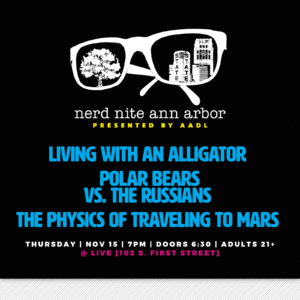
Join us at NNA2 #60 for amazing tales (tails?) from the front lines of animal rescue, battlefields, and plasmadynamics! Staff from the Creature Conservancy will share their mission of animal conservation through education with stories from some of their more unusual permanent residents. Local historian James Mann will take us back to 1918 and the time Michiganders fought the Bolsheviks on their own turf. And then physicist Marcel Georgin shoots his mouth off about the advanced rocket propulsion systems that’ll someday take us to Mars. Kick back with friends, throw back a drink or two, and enjoy Nerd Nite A2!
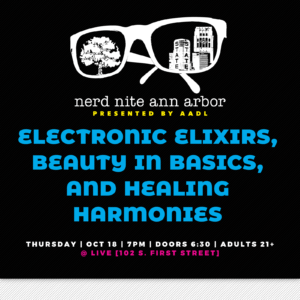
Gather ‘round, nerd friends, for another amazing entry in our NNA2 adventure! Join us as Manorama Kadwani explains ways bioelectronic therapies could solve medical pee-mergencies (and others), artist and author Hannah Burr discusses her work at the intersection of fine art and science, and music therapist Callie Finzel rhapsodizes about the amazing effects music can have on the brain. It’s going to be fun!!!! It’s going to be interesting!!!!! It’s going to be NERD NITE A2!!!!!!!!! So don’t miss out – bring a friend, grab a drink, and grab a seat!
When: Thursday, 10/18/2018
Doors at 6:30/talks at 7 pm
Where: LIVE, 102 S. First St.
Cost: Free, courtesy of the Ann Arbor District Library
 Manorama Kadwani – Bioelectronic Medicine: talking with nerves
Manorama Kadwani – Bioelectronic Medicine: talking with nerves
People with the problem of frequent need to pee want to get back their bladder control. Patients of such a neurological disorder suffer from not only physical problems, but it affects their work performance, social outings and there’s a stigma about others getting to know about it. Conventional therapies like drug prescriptions have side effects and surgeries do not help many bladder dysfunction patients. So what else can help them? There are prosthetic devices in the market, based on a new therapy called Bioelectronic medicine. My research is focused on understanding the mechanism of this therapy by creating computational simulations of neurons and their interaction with these tiny prosthetic devices. So is this the alternative therapy of future? Can it help patients of other neurological disorders?
About Manorama: I am a Master’s student at the University of Michigan. I am pursuing research under Dr. Tim Bruns, focusing on a type of sensory neurons and their interactions with tiny prosthetic devices with the ultimate aim of designing better prosthetic devices for bladder dysfunction. In my free time, I like to explore what Ann Arbor has to offer for art lovers! I have always loved sketching, but to improve my craft I like to attend the drawing classes in AADL. I am also beginning to learn the Ballroom dancing, because dance makes me happy!
 Hannah Burr – Art Among the Elements
Hannah Burr – Art Among the Elements
Burr will describe the slog and float of creating an artists book about the elements: the essential learnings of her creative process, what she’s extracting from the silos of science, and how much weirder reality is than expected.
About Hannah: Hannah Burr is a Boston MA native who has lived in A2 for just over a year. She’s a contemporary artist and author of two books on the intersection of creative and contemplative practice. Her third book, on the naturally occurring elements of the periodic table, will be out this winter. Burr is a Cum Laude graduate of Brown University and tends to create bridges through her projects to subjects too specialized or fleeting for most people to engage with, including practices sometimes called religious or spiritual, and recently, scientific. Burr’s artwork has been exhibited in the contemporary wing of the Museum of Fine Arts Boston, the Currier Museum in NH, and the Drawing Center in New York NY. Follow her on Twitter @good_bonfire.
 Callie Finzell – Musical Mentality: A Melodious Monologue on Music and the Mind
Callie Finzell – Musical Mentality: A Melodious Monologue on Music and the Mind
Music, like love, is all around. It permeates our everyday lives in both obvious and more obscure ways. This talk will dive into the weird world of musical neuroscience and its applications for therapy. How is music processed in the brain? How can it be used to effect movement, alleviate pain, improve cognition, and facilitate well-being? And what do government-funded LSD research trials have to do with it?
About Callie: Like many who have graced this stage before her, Callie Finzel, MT-BC, has a few letters behind her name and plenty of nerdy interests…that are completely irrelevant to this talk. A graduate of the University of Michigan and Eastern Michigan University, Callie is a music therapist in hospice care who sings and plays piano, guitar, and whatever miscellaneous percussion instruments show up around the house. She is interested in the interaction between music interests and conception of self because, as the Fraggles say, “music makes us real.” When she’s not playing, listening to, or thinking about music, Callie enjoys baking, reading, watching supernatural tv shows with strong female leads, and 100%-ing the Lego Harry Potter video games, with or without the help of her wife and cats.





























